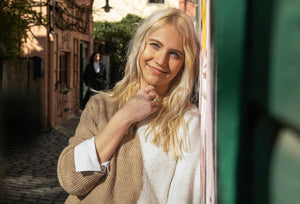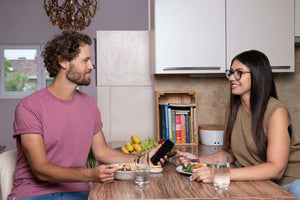In this article, one of our beloved users shares what she learned through using the Hello Inside app. Martina's story demonstrates how individually our bodies respond to diet and exercise, and she shared some of her most interesting insights with us.
Hello Inside: Dear Martina, please tell us how Hello Inside all started?
Martina: Shortly after I decided to understand my body even better, I was holding the Hello Inside package in my hands. I was very excited, but also a little nervous, because the sensor is attached to my upper arm with a small needle. The needle doesn't stay in place, just a thin thread, but I was still skeptical about how it would work. After reading the instructions carefully, I first cleaned my upper arm, checked the area for moles, and then I was off. Bam! I ignited the applicator (the one with the needle) and fired the sensor into my upper arm, almost painlessly. Almost, because it tingled a little at first. But this feeling disappeared relatively quickly, so I soon couldn't feel the sensor anymore. Which was logical, too, because the sensor is only the size of a 2-euro coin. After the sensor calibrated itself with the app within an hour, the four-week glucose journey could begin.
Why did you want to measure your blood sugar?
For a long time, I only knew about continuous glucose monitoring (CGM) for people with diabetes. However, in recent months, I've heard more and more often that healthy people can also track their glucose metabolism. Not only to prevent health risks, but also to get to know their own body better. I was also curious to see what real-time and long-term monitoring of my own glucose levels would reveal about certain foods, sleep, exercise, stress, and even my cycle.
What was one of your first questions?
Is the sensor waterproof? Since I go swimming once or twice a week and occasionally go wakeboarding, I didn't want to limit myself in these activities. During my first swims, I wore a waterproof bandage. However, since this bandage didn't stick and fell off my arm relatively quickly, I simply left it off. The result: The sensor can stay in the water for an hour, and sauna visits without a bandage are also possible. However, you should be aware that the sensor's adhesive can loosen during longer water activities and thus eventually fall off. I ended up using a tape that kept the sensor in place during physical activity. (Note from Hello Inside: We are currently looking for a supplier for Hello Inside bandages, so you don't have to organize your own bandages.)
What was your biggest surprise?
That was definitely my morning cocoa with oat milk. I wasn't expecting such a high spike (spike = rapid increase in glucose levels). On the one hand, you avoid cow's milk for various reasons, but on the other hand, oat milk apparently also has its downsides. At least for me. (Note from Hello Inside: Many other users also report a sharp rise in blood sugar when consuming oat milk, even without added sugar.)
For me, this was the beginning of my journey into the world of milk alternatives. I wasn't going to accept this result. So I bought all sorts of milk alternatives, from pea milk, rice milk, coconut milk, almond milk, to oat milk with zero percent sugar. Conclusion: The pea milk was my personal blood sugar winner. Due to its higher protein content and lower carbohydrate content, it has hardly any impact on blood sugar. Coconut milk and almond milk only slightly raise blood sugar levels and don't cause a spike. The rice milk and oat milk lead to a relatively high and rapid rise in glucose. The biggest surprise for me, however, was the oat milk with zero percent sugar. I really hadn't expected a blood sugar level of 180 mg/dl (see Figure 1).

What other insights have you gained about your diet?
Pizza and pasta are notoriously loaded with carbohydrates. One day, I had a pizza and chocolate pudding for dessert, and soon after, I experienced a glucose spike (see Figure 2). Nothing surprising. Another day, I ate carbonara with red wine, pistachio, and vanilla ice cream, and my blood sugar remained stable (see Figure 3). At first, I thought it might be due to the phase of my cycle. Upon closer analysis, however, I realized that while pasta carbonara contains carbohydrates, it also contains a large amount of protein and fat (from eggs, bacon/ham, and cheese). The pistachio ice cream also contains quite a bit of fat... and then there's the effect of the alcohol. So, at first glance, this combination of protein, fat, and carbohydrates plus alcohol seems to have been okay for my blood sugar.


Hello Inside on alcohol and blood sugar:
At first glance, it might seem like the solution is to pair alcohol with carbohydrate-rich meals. The influence of alcohol in the form of wine, sparkling wine, or spirits causes blood sugar to drop significantly (or prevent a sharp rise), because the body wants to metabolize the alcohol as quickly as possible. The liver initially tries to break down the alcohol and render it harmless, but the liver also produces sugar to release into the blood. Because breaking down the toxins is the liver's priority, it cannot release sugar into the blood during the same time, causing blood sugar levels to drop.
Those sound like very exciting observations and quite a few aha moments. You also mentioned at the beginning that you wanted to know how your blood sugar relates to your cycle. What did you discover?
It seems that my blood sugar is more consistent during my luteal and menstrual phases than during the proliferation phase. Since I ate the same breakfast every day, consisting of gluten-free oats, almond butter, wild blueberries, and date syrup, I noticed significant differences. During my luteal phase, this breakfast had little effect on my blood sugar. In contrast, during my proliferation phase, I noticed a greater increase in blood sugar. However, to make this determination with more certainty, I would have to complete the Hello Hormones program a second time. Then I could determine more precisely which foods have what effect in which phase.
What you've observed is really interesting. How would you summarize your findings?
Through the four weeks of continuous glucose monitoring, I gained my first good insight into the influence of certain foods, sleep, exercise, stress, and my cycle on my blood sugar levels. It also made me realize again how complex the human body, and especially the female body, is. It showed me once again how unique each person is. What works for me might not work for my friends. This "introspection" is a wonderful example of how general nutritional recommendations are general but not individual. During this time, I also really realized that the individual phases of my cycle deserve much more attention, as different glucose reactions can occur depending on hormones. The most important thing, however, is not to drive yourself crazy, but to make conscious decisions. Because sometimes I just feel like a coffee with oat milk, some vanilla ice cream, or a glass of wine.
So thank you for letting me try the Hello Hormones program. It allowed me to learn what my body likes and dislikes, and which factors influence my blood sugar and how strongly.

Martina Zollner, sports scientist and athlete, shared her experience with the Hello Inside app in this interview.



